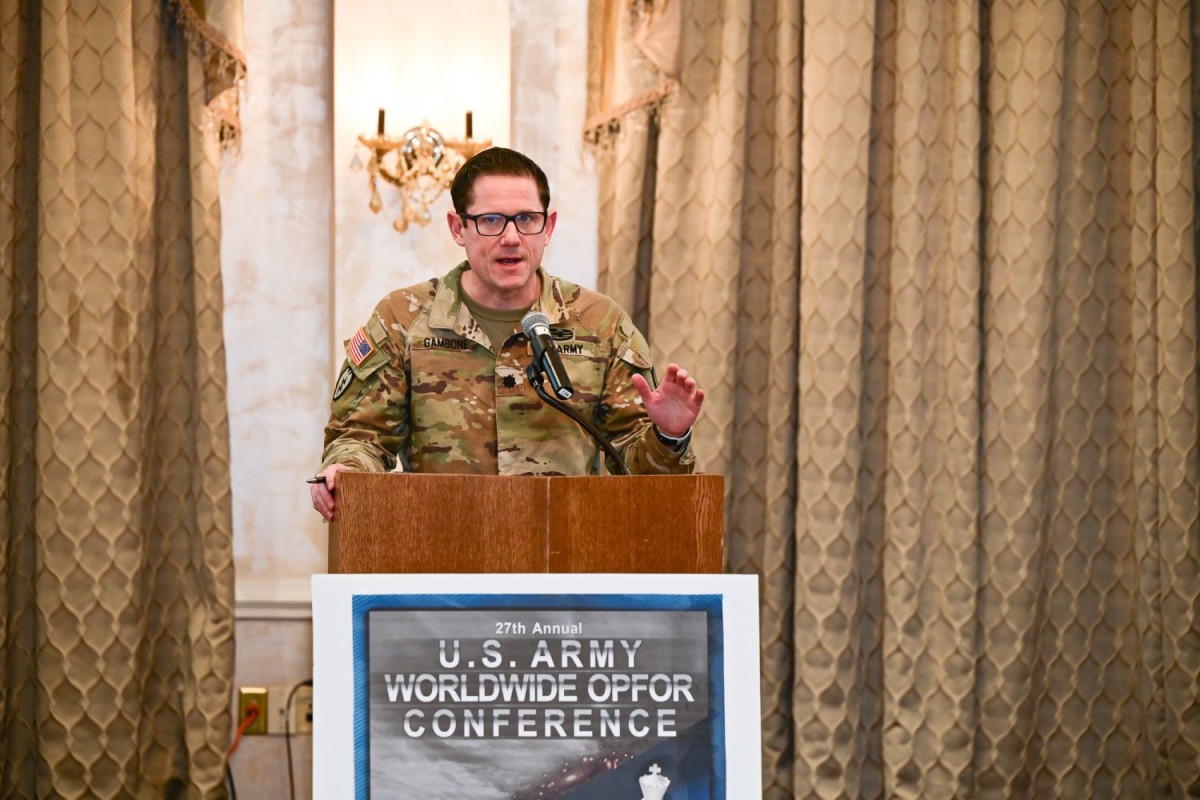JOINT BASE LANGLEY-EUSTIS, Va. – U.S. Army Training and Doctrine Command G-2 hosted the 27th Annual Worldwide Army Opposing Force Conference from Feb. 27 to Mar. 1.
More than 100 leaders attended the conference which brought training experts together from across the Army, joint, and international communities to discuss lessons learned and best practices, and address Opposing Force training gaps. Attendees also learned about the current and future operational environment and discussed ways to enhance the OPFOR in both tactics and capabilities to provide U.S. and international forces with realistic scenarios during exercises.
Ian Sullivan, the TRADOC G-2 deputy chief of staff for Intelligence, opened the conference by discussing the pacing threats and how the Army should prepare to fight.
“A couple of years ago, I was briefing Chief of Staff of the Army General James C. McConville about the operational environment, when we were moving away from a capabilities focused OFPOR to threat based,” Sullivan said. “He told me we need to know the [Chinese] People’s Liberation Army like we knew the Soviets.”
Lt. Gen. Milford Beagle, commanding general of the Combined Arms Center and keynote speaker at the conference, reiterated the importance of understanding the PLA.
“I recognize there are training objectives that need to get met, but at the same time, the first time you know we are in contact with a PLA Combined Arms Brigade, we shouldn’t be surprised, right?” he asked.
Sullivan told attendees about what he sees as the key for winning the fight against our adversaries.
“Understanding the adversary is going to be critical,” Sullivan said. “The threat that we face with the PLA is different than any threat we have faced in a long time.”
Sullivan explained that China’s military is rapidly modernizing to meet a 2027 benchmark directed by Chinese President Xi Jinping. He told attendees that he expects the U.S. Army and Joint Forces to always have a strong competitive advantage.
“One edge we have is our people,” Sullivan said. He then went on to emphasize that people must be the main focus.
Attendees learned about a variety of topics on the OE and OPFOR, including lessons learned from the Russia-Ukraine conflict, PLA modernization, threat material created by TRADOC G-2, and OE Simulation Challenges.
“I enjoyed learning about everything going on in the OE, especially how to prepare for near-peer adversaries,” said Capt. Sylvie Russell, Joint Multinational Readiness Center Intel Officer. “The hardest part is trying to replicate the threat realistically to give brigade combat teams real training before they go to real environments.”
Allied and partner leaders also actively participated, with briefings by the U.K., Japan, and Singapore on their use of OPFOR during training. On day three, the conference split into two working groups that engaged in extensive discussion about OPFOR replication gaps based on emerging trends in current conflicts such as Ukraine and Israel. This led to the development of 10 prioritized recommendations within the live, virtual, and constructive domains to enhance OPFOR modernization efforts. Of particular interest to the community was the need for improved OPFOR unmanned aircraft systems and electronic warfare capabilities to better reflect tactics being used by Russia.
“UAS in combat have increased in ability with the adaptive use of commercial hobbyist innovations,” said Darryl Perry, an analyst in TRADOC G-2’s OPFOR Modernization Branch. “Racing drones that are flying at over 80 mph change the defensive equation. There are major efforts to counter the systems that are responsible for jamming and develop extensive protection systems, all under the umbrella of EW. Combining these two aspects changes the face of battle.”
Based on discussions from the Russian-Ukraine conflict in which anti-tank guided missiles enjoyed great success against armored vehicles, especially for the Ukrainians, the work groups identified the need for a greater quantity of ATGMs by dismounted OPFOR to provide a realistic threat for our training units. This not only replicates the modern-day threat on the battlefield, but further challenges units training to deal with the complexities of Multi-Domain Operations tactics across the domains of air, land, sea, space, and cyber.
The prioritized gaps were briefed at the conclusion of the conference and will be used to inform senior leader decision making going forward. If approved, these will be applied to training at Combat Training Centers to better prepare our units against realistic peer and near-peer threats, leading to improved readiness by 2027.
